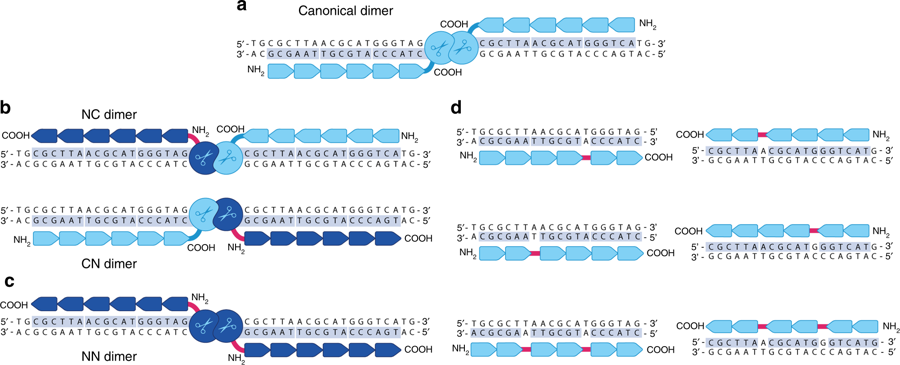
Sangamo Therapeutics researchers today published data in Nature Communications showing the latest improvements incorporated into its second-generation zinc finger nuclease (ZFN) platform technology, which the company said will enable highly precise editing of chosen genomic loci.
Those improvements, Sagamo said, yielded a 64-fold increase in the diversity of ZFNs available for targeting any DNA segment, according to the manuscript, “Diversifying the Structure of Zinc Finger Nucleases for High-Precision Genome Editing.” The corresponding author, Edward J. Rebar, PhD, is senior vice president and CTO of Sangamo.
The manuscript described protein engineering work by Rebar, David Paschon, PhD, and colleagues at Sangamo that has led to the development of new ZFN architectures. The modifications include the reversal of the order of the DNA binding and nuclease domains, as well as the incorporation of new linkers that enable base skipping between otherwise adjacent fingers within each ZFN.
By using architectural diversification as a strategy, the Sangamo researchers said, they sought to substantially increase the targeting precision of ZFNs.
Using selection-based methods, the researchers developed new linker options for spanning finger–finger and finger–FokI cleavage domain junctions. Those options, they reported, produced a 64-fold aggregate increase in the number of ZFN configurations available for targeting cleavage to any chosen base.
The Sangamo research team also assessed 30 of the new ZFN configurations, identifying active nucleases for 97% of those tested.
“We further show that our new linker components can be combined with available zinc fingers to enable targeting of an arbitrarily chosen genome segment (in HBG1) at a density approaching 1.0 (i.e., ZFNs available for targeting almost every base step),” the investigators reported. “To our knowledge, this study provides the first published demonstration of the targeted base-by-base tiling of an endogenous locus with engineered nucleases. Finally, we have shown that these architecture improvements can be used to substantially improve the targeting precision of ZFNs constructed using fingers from other sources.”
Enhancing ZFN’s attractiveness
By improving the precision of ZFN, Sangamo aims to enhance the technology’s attractiveness compared with CRISPR: Criticisms of ZFN over the years have included its cost and speed compared with CRISPR, as well as the time and skill needed to develop a high-quality gene snipping product compared with CRISPR. Rebar told GEN in 2017 that Sangamo had been working on shortening lead development cycle times for ZFN.
“The new architectures, which have substantially improved our targeting capabilities, will help ensure that we can target the optimal window for any therapeutic application. This speaks to the versatility of our ZFN genome editing technology,” Rebar said in a Sangamo statement.
“In developing nucleases for any therapeutic application, a critical requirement is the ability to position the double-stranded break for maximal clinical efficacy. In many cases, this consideration restricts the optimal cleavage target to a narrow sequence window, and for this reason, increasing targeting precision has been a longstanding concern in the field,” Rebar added.
Sangamo announced the publication of the manuscript a month after its release of interim results from a pair of Phase I/II trials assessing two of its ZFN genome-editing candidates for two types of mucopolysaccharidosis (MPS). The studies showed favorable safety profiles and some expression of key enzymes, though not as much efficacy as the company had hoped.
“It’s working and it’s not sufficient for a clinical benefit,” Sangamo CEO Sandy Macrae, MBChB, PhD, told analysts on February 7.
The disclosure led to a stock selloff that caused Sangamo shares to lose nearly one-third of their value, falling to $8.31 from $12.02 the previous day. Shares have since begun to rebound, having closed yesterday at $9.50.
Increasing design options
In the manuscript, the Sangamo researchers reported that they developed new linkers that attach the FokI nuclease domain to the amino terminus of the DNA-binding zinc finger array, a change from the carboxy terminal attachment used in older ZFNs.
The modification allowed the design of nucleases in which each ZFN of a dimer is able to recognize either DNA strand, yielding three alternative ZFN dimer configurations, effectively increasing the number of design options for any target sequence by a factor of four, Sangamo said.
New linkers were also developed that allow base-skipping between adjacent fingers within a zinc finger array. The new linkers enabled an engineered ZFN to bind alternative, partially frame-shifted DNA sequences with new zinc finger designs while maintaining the same cleavage site, thereby increasing the number of design options by an additional factor of 16.
“Incorporating both improvements into our ZFN platform resulted in an overall 64-fold increase in the number of ZFN design options available for efficient genome editing at any target cleavage site,” the researchers reported.
The manuscript also highlighted preclinical studies performed using the new ZFN architectures, which according to Sangamo demonstrated a high degree of precision, efficiency, and specificity across three therapeutic applications.
“This system could be applied to selecting improved linkers for the canonical ZFN architecture, as existing linkers were developed via screening of a small panel of discreet linker alternatives,” the Sangamo team concluded. “This system could be explored for selecting linkers in the context of other classes of engineered enzymes such as TALENs, FokI-dCas9, and Cas9 base editors, in order to improve the performance of those systems.
“The results presented here should broadly facilitate the application of designed ZFNs toward more diverse and challenging applications in research, biotechnology, and therapy,” the investigators added.

